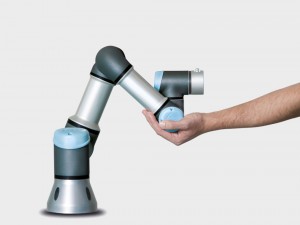Source: Hannover Messe
For small to mid-sized manufacturers, any gain in productivity can have a huge impact. Automation offers significant advantages, but many small and mid-sized enterprises (SMEs) believe that robotics is out of their reach. These organizations can’t afford large, complex robots that don’t fit within their limited floor space, that require specialized personnel to program and maintain them, and that are simply too expensive, with a payback period that is too long to justify the investment.
But a new generation of collaborative robots (or “cobots”) is changing the game for smaller manufacturers, helping them compete more effectively, offering new opportunities for employees, and even improving worker safety. Look for these 5 essential requirements that will put robotics within your reach.
1. Quick set-up
Setting up a conventional industrial robot can take days or even weeks. That’s time and disruption that SMBs simply can’t afford. When you’re ready to automate, you or any untrained operator need to be able to unpack your new robot, mount it, and begin programming simple tasks in a matter of hours. Collaborative robot arms weigh as little as 11 kg (24.3 lbs), and can be set up in less than a day.
Shane Strange, automation and integration specialist with faucet maker RSS Manufacturing and Phylrich in Costa Mesa, CA, had this experience: “Once the robot actually hit the floor, we got it unboxed and found a stand for it, and within 45 minutes we had it up, powered, and were actually programming the robot, doing simple back-and-forths and pick-and-place.”
2. Easy to program without special skills
Most SMEs don’t have a robotic programmer on staff—and can’t afford to hire one. But innovative new robotic technology lets operators with no programming experience quickly program robotic movements based on logical process steps and using intuitive tools. When electronics manufacturer Scott Fetzer Electrical Group in Nashville installed a UR robot, line lead Sebrina Thompson stated that anyone who can work a smartphone can use the robots.
3. Collaborative and safe, even in small shops
Conventional industrial robots require a large, separate enclosure, which adds cost, takes up operational space, and reduces flexibility on the production floor. Management also has to be concerned with the safety risk if someone manages to get inside the enclosure while the robot is activated. But small manufacturers can’t afford to dedicate large areas to robotic operation. Today’s collaborative robots can work side-by-side with human workers in complementary operations. For example, the innovative force-sensing technology built into “cobots” means the robot stops operating if it comes into contact with a human.
4. Flexible deployment for multiple uses
Dedicated industrial robots can limit small and mid-sized manufacturers who often have small production batches and require fast change-overs. In contrast, new collaborative robots are lightweight, space-saving, and easy to redeploy to multiple locations without changing the production layout. And with the ability to reuse programs for recurring tasks, they support agile manufacturing processes with minimal set-up time and effort.
5. Fast payback of your investment
Of course, any automation investment for a small or mid-sized manufacturer must pay for itself as quickly as possible. Universal Robots gives you all the advantages of advanced robotic automation, with none of the traditional added costs associated with robot programming, set up, and dedicated, shielded work cells. And with an average payback period of just 195 days, robotic automation is finally affordable for small and mid-sized manufacturers.
To learn more about what collaborative Robots can do for your manufacturing operation, visit HANNOVER MESSE-Exhibitor Universal Robots and many other exhibitors in the fields of robotics.


